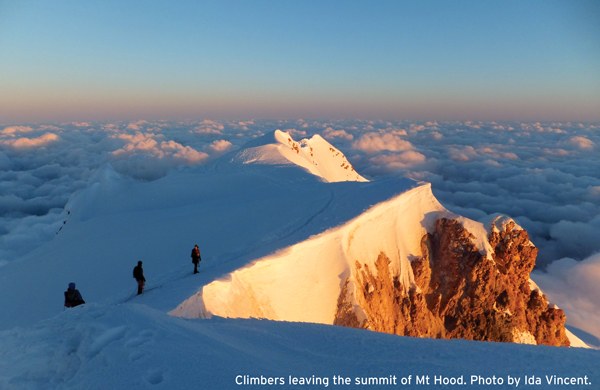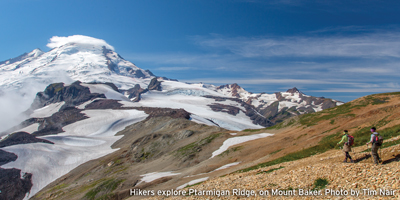
BY JILL SANFORD
As Mountaineers, we have accessed and experienced some of the most remote areas of this region. Close your eyes and think about where you were on you favorite or most recent trip outdoors. Chances are this trip brought you to some sort of protected land, quite possibly to a federally designated “Wilderness” area, such as the Olympic Wilderness, the San Juan Wilderness, Mount Rainier National Park, Glacier Peak Wilderness, Boulder River Wilderness and more.
The Wilderness Act turned 50 years old this year. On September 3, 1964, President Lyndon B. Johnson signed the act that defined these areas as places “where the earth and its community of life are untrammeled by man, where man himself is a visitor who does not remain.” The act immediately protected about 9 million acres of our country’s most beautiful and pristine landscapes from human development. Over last 50 years, another 100 million acres have been designated as federal Wilderness areas. This is the highest level of protection an area of land can receive in the US, preventing against motorized recreation, logging, mining, drilling, road building, off road vehicle use and industrial structures within the designated area.
Like many Mountaineers, I can’t imagine living without our beautiful Cascades and Olympics. They greet me from my office window and on my daily drive. On the weekends, I escape to these mountains and I feel like they are welcoming me home. It’s easy to take the laws that protect them for granted because they are such a huge part of life in the Northwest, necessary for so many of us for both recreation and relaxation.
Ask any Mountaineer what wilderness means to him or her, and you will usually get an introspective and thoughtful response. Mickey Eisenberg, a local guidebook author, volunteer instructor, avid naturalist and Mountaineer since the 1970s, says, “In my mind the wilderness has always represented a way of reconnecting us and reminding us of what this mystery of life is all about. That reconnection is where many people find rejuvenation and connection, where they center and calm themselves, or reach a Zen like experience. All of those are terms that different people might use but they are all getting at something similar. It’s connecting us with nature to remind us of our nature.”
PRESERVING WILDERNESS PRESERVES LIFE
Aside from the dual benefits of a place to play and a place to reconnect, the Wilderness areas in this region are also the untold heros of preserving life as we know it around and on the Puget Sound. Mindy Roberts is another Mountaineer who loves outdoor recreation as a personal recharge, and as the organization’s Safety Officer as well as a climbing instructor for the Tacoma branch she has a fair amount of experience enjoying Wilderness areas. She is also an Environmental Engineer for the Department of Ecology, and her professional work leads to an even greater respect for these protected lands.
“Over 90% of the water that reaches Puget Sound is from wilderness areas and other forested and alpine areas around the Puget Sound,” Mindy explains. “It is incredibly important to protect these lands in their natural state.” She monitors the water that flows into the Puget Sound and her findings are drastic. “The water coming out of streams in Wilderness areas and forested lands is much cleaner than the waters coming out of even lightly residential or agricultural lands, which are contaminated with heavy metals like zinc and lead. We also see it in terms of nutrient contamination that drives algae growth in Puget Sound.”
Washington State has 31 federally protected Wilderness Areas, and we are lucky. They allow areas that aren’t protected to be cleaner and safer for us to live in. Mindy also uses these areas to more clearly understand what the human impact has been on non-protected places and to gage how our ever increasing population will continue to impact the environment. “In other parts of the country they don’t have the luxury,” she says, because the relatively large amount of Wilderness Areas in this state “provide enormous benefits in terms of buffering our human impact.”
A lot of the challenges we face in the Puget Sound region would be a lot more intense if we didn’t have these federal lands set aside for wilderness enjoyment. While Mindy’s background is in science, she also emphasizes the role of policy and government in preserving our Wilderness areas. “We take it for granted that these places have always been there and will always be there in the future. They are only there now because people took the time to advocate for them through a political process, which is very tricky these days. Continuing that advocacy even just to take care of the places that are already there is
incredibly important.”
ADVOCACY, POLICY AND THE NEXT 50
The Mountaineers is working on ways to engage our members more in advocacy, including educational materials on issues affecting public lands conservation and recreation, and opportunities to comment on land planning and leglislative processes, according to Conservation and Advocacy Director, Katherine Hollis. Thanks to her efforts and the foresight and leadership of Executive Director Martinique Grigg, The Mountaineers has a strong relationship with other advocacy and policy groups, both regionally and nationally.
The Wilderness Society is one of these organizations, and while based in D.C., the Governing Council Chair, Doug Walker is a Seattle local and an active member of The Mountaineers.
“The Wilderness Society and The Mountaineers have a very collaborative relationship,” he explains. “Collaborating leads to better policy.” For example, The Mountaineers and Wilderness Society have collaborated for over five years nationally on improving facilitated access on our national public lands.
There are over 11,000 active Mountaineers members and that number is growing every year. “The Wilderness society is really focused on building the constituency for federal lands and Wildernesses in particular,” says Walker. The best way to do that is to get people outdoors and get them invested in the future of our Wilderness areas, a mission that fits like a glove to a hand with the Mountaineer’s own goals.
 Over 110 million acres of land nationwide have been protected under this act over the last 50 years. But the question on everyone’s mind it, what about the next 50? While there could be multiple contributing factors to the future of this act, there is fact that we just can’t deny. The American political climate is a lot more diverse today than it was in 1964, but you wouldn’t know it from the primary demographic of outdoor recreation.
Over 110 million acres of land nationwide have been protected under this act over the last 50 years. But the question on everyone’s mind it, what about the next 50? While there could be multiple contributing factors to the future of this act, there is fact that we just can’t deny. The American political climate is a lot more diverse today than it was in 1964, but you wouldn’t know it from the primary demographic of outdoor recreation.
“96% of visitors to our national lands are Caucasian,” Doug reveals. “Wilderness is lacking relevancy to a lot of emerging audiences and that contributes to diminished passion for our issues. And so we want to grow the constituency so we have greater awareness and relevant engagement with a larger public. We want to see wilderness and our organization reached by larger audiences.”
Again, that is where organizations like The Mountaineers are helping lead the way. Our youth outreach and the Mountain Workshops program seek to bring a love for the outdoors and a passion for conservation to a new, diverse demographic that will continue to expand and inspire. At the core of the Mountaineer’s is a mission to teach skills and stewardship to those who have never been exposed to outdoor recreation. We are heading in the right direction, yet there is still a great deal of work to be done over the next 50 years to ensure that environmental conservation is not just a static idea of the past.
But as any Mountaineer can tell you, it is not common to take a walk in the woods and leave without a stronger relationship to the environment than we had when we first arrived. It is that universal feeling of rejuvenation and interconnectedness that long-time member Mickey Eisenberg describes and that we can all recognize. Involvement leads to investment, especially in an organization like ours where it is common to see someone join a class with little to no knowledge about their activity and end up just a few years later as a volunteer instructor or committee head.
The fight for our public lands conservation needs individuals like those who belong to The Mountaineers and it needs The Mountaineers to continue to teach and lead these people as they become invested in the future of outdoor recreation.
“I’d like to believe, and I do believe, that the more people who are aware of the fragility of our wilderness areas and the need to protect, preserve and expand it, the more able we will be able to preserve it for future generations,” Mickey says. This simple belief that is shared by so many of us Mountaineers, to facilitate more people from more diverse backgrounds becoming invested in Wilderness, just might be the catalyst that will determine the next 50 years.
This article originally appeared in our November/December 2014 issue of Mountaineer magazine. To view the original article in magazine form and read more stories from our publication, click here.
 Jill Sanford
Jill Sanford